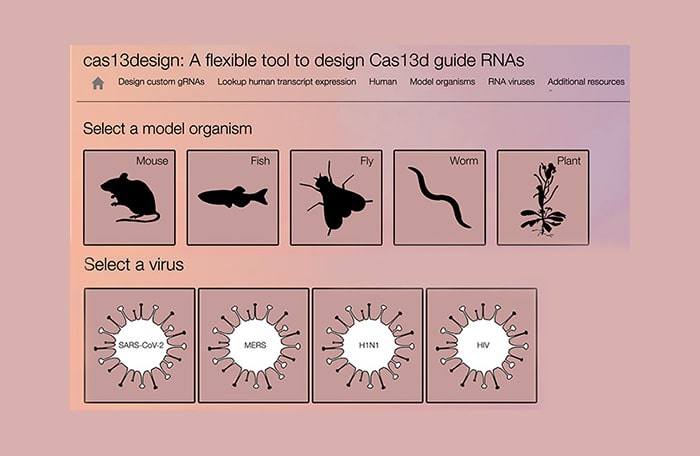Last year, researchers in the lab of Neville Sanjana, PhD, at the New York Genome Center (NYGC) and New York University (NYU) unveiled a suite of CRISPR-based tools to probe RNA in human cells in a high-throughput fashion using a RNA-targeting CRISPR enzyme (Cas13). Now, as detailed in a report published today in Cell Genomics, the lab has expanded this resource to enable researchers to optimize Cas13 guide RNA selection for six frequently used model organisms – human, mouse, zebrafish, fly, worm, and a flowering plant – as well as four viral RNA pathogens – influenza H1N1, HIV, the coronavirus MERS, and SARS-CoV-2, the virus responsible for the COVID-19 pandemic. The authors have made the CRISPR-Cas13 guide RNAs designs available online via a dedicated website: cas13design.nygenome.org.
“A key feature of our study was to understand whether we can efficiently target viruses despite their constant mutations. We analyzed thousands of variants of coronaviruses and retroviruses to find optimal regions for targeting their RNA genomes,” said Xinyi (Cathy) Guo, a graduate student in NYU’s Department of Biology and the Sanjana Lab member who is the study’s first author.
The team focused on three areas: designing and scoring Cas13 RNA guides targeting protein-coding RNAs and noncoding RNAs across the six model organisms; developing a web-based application to design Cas13 guide RNAs for custom RNA targets outside of these organisms; and determining the minimal number of Cas13 guide RNAs needed to target RNA viruses that undergo frequent mutation.
The researchers anticipate that their expanded resource will help to facilitate and expedite CRISPR-Cas13 targeting studies for diverse applications. In addition to the designed genomes, the tool also can optimize Cas13 reagents for custom RNA sequences entered by the user. This enables optimized guide RNA selection for other species not included in the tool and also for human transcripts carrying specific genetic variants. The group also demonstrated efficient Cas13 targeting and knockdown of long noncoding RNAs in both human and mouse cells, paving the way for high-throughput interrogation of noncoding RNAs.
“Following the release of our initial study using Cas13 for pooled screens in human cells, we were surprised to receive many requests to help with Cas13 guide RNA design for other organisms. At some point, it became clear that the community needed better tools to use Cas13 in their own work. So we got to work expanding our Cas13 guide RNA scoring tools beyond the human transcriptome,” said Dr. Sanjana, Core Faculty Member, NYGC, Assistant Professor of Biology, NYU, and Assistant Professor of Neuroscience and Physiology, NYU Grossman School of Medicine, the study’s senior author.
Other co-authors on the study are postdoctoral scientists Hans-Hermann Wessels, PhD, and Alejandro Méndez-Mancilla, PhD, who are the co-first authors of the earlier study, Jahan Rahman, previously a NYU undergraduate and now a research associate in the lab, and NYU Biology graduate students Daniel Haro and Xinru Chen.
